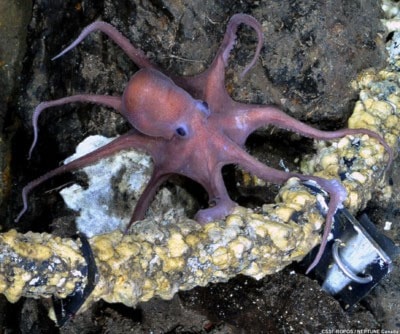What do two Roman gods, 800 km of fibre optic cable and the Maritime Museum of B.C. have in common? They’re coming together to show Victorians What Lies Beneath — a new exhibition that explores the deep waters surrounding Vancouver Island.
Giving us a porthole into this largely unexplored territory is Ocean Networks Canada, a Victoria-based world leader in deep-sea research and technology.
ONC, a UVic non-profit initiative to find innovative new technologies to explore the Pacific Ocean has two underwater networks, NEPTUNE and VENUS, that monitor the ocean in real time with various scientific instruments attached to submerged concrete nodes.
VENUS (Victoria Experimental Network Under the Sea) is the coastal network that collects information from the Strait of Georgia and the Saanich Inlet from a depth of 40 to 300 metres.
NEPTUNE (North East Pacific Time-series Undersea Networked Experiments) is the regional network, with five 13-tonne undersea nodes spread out from Vancouver Island’s west coast, from the continental shelf across the Abyssal plain and into the mid-ocean range (NEPTUNE’s nodes form a loop across the North American plate and the Juan de Fuca plate).
These nodes have the ability to track plate tectonics, seismicity, volcanism, deap-sea hydrothermal vent and extremophile eco-systems, ridge floor ocean currents, tsunami propagation, earthquakes, sediment transport, marine mammals, ocean biochemistry and so much more.
Opening Thursday, Jan. 12, with a presentation by Let’s Talk Science and a talk by Verena Tunnicliffe (director of VENUS and Canada Research Chair in Deep Ocean Reserch at UVic), What Lies Beneath offers photos and video from ONC’s extensive research, some of their previously submerged equipment (a hydrophone, heat probe and wire wind cylinder that were submerged for various lengths of time), a kids corner packed with ocean related books, activities and crafts, a timeline of diving (scuba, salvage, submarines and more) and a main display about the networks, their research and ongoing benefits. Every day at 1 p.m., the museum in Bastion Square will show a live feed from one of the networks’ observatories.
A speaker series runs in tandem with the exhibition on the last Wednesday of the month until August, featuring Tunnicliffe on Jan. 25 at 7 p.m.
Her presentation, “Exploring the ocean frontier: We have much to learn,” will explore the deep places of our ocean with imagery from expeditions to hot vents and sub-sea volcanoes.
Howie Robbins, president of the Artificial Reef Society of B.C., is giving a talk Feb. 22 (7 p.m.) called Artificial Reefs: Paradise or Pollution, which explores ARSBC’s 23-year history of turning old naval ships, a 1,778-foot coastal freighter and even a Boeing 737 into artificial reefs in the waters around the Island. M
For more information about What Lies Beneath, visit mmbc.bc.ca. For more information about NEPTUNE and VENUS, visit oceannetworks.ca.
